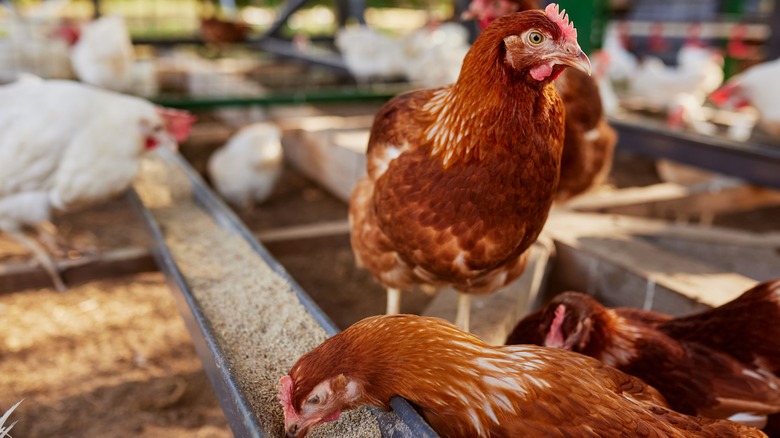Why The 'Hormone-Free' Label On Your Chicken Is Basically Meaningless
In highly competitive industries, marketing and sincerity don't always go hand in hand. Whether they omit important nutritional information or exaggerate eco-friendliness, food and beverage companies can lure consumers into believing their products are cleaner, safer, and healthier than they are in reality. Capitalizing on a public desire for ethically sourced and additive-free proteins, meat and poultry labels are often misleading and deceptive.
Supermarket meat aisles are full of options, so it's common sense to make a selection informed by the details on the packaging, such as a "hormone-free" label on raw chicken. Despite the enticing label, chicken packaging with a hormone-free stamp isn't inherently superior to its counterparts lacking this claim. The USDA prohibits the use of hormones in all poultry products. So, while the label isn't an explicit lie, it's misleading to suggest that hormone-free labeled chicken is any different from other chicken products in terms of hormone use. Although the FDA allows antibiotic administration for disease prevention in chickens, a withdrawal period and extensive testing for residual antibiotics are required before the animal is considered safe for consumption.
Why poultry hormone-injections are banned
Contrary to the popular belief that chickens in the United States may be injected with growth hormones, the practice has been banned since the 1950s – multiple generations ago. Although hormones were once used to hasten and bolster the growth rate of chickens, the practice was banned for good reason.
For starters, hormones are difficult to administer and the process can be stressful and agitating for individual chickens. Plus, it can impact the overall health and productivity of the entire flock. Not only can they impact the well-being of chickens raised for consumption, but hormone injections are not commercially distributed, which makes them expensive and difficult to obtain. Because they're banned, the effects of hormone-injected chickens on humans are not well-studied.
Even without hormones, the size of chickens raised for consumption has increased over the years. Thanks to selective breeding, improved living conditions, and higher-quality veterinarian care, there is no benefit to injecting chicken with hormones.
Purchasing high-quality chicken
You don't need the ultimate guide to understanding meat labels to know how to source chicken that satisfies your requirements for high-quality poultry. Here are some telltale signs of good chicken.
All poultry is labeled with a "grade." Grade A chicken indicates that the chicken meets certain quality standards in terms of appearance, texture, and absence of defects, making it the best choice for high-quality chicken. Opting for free-range chicken ensures that the birds are granted access to outdoor areas to roam, forage, and engage in natural behaviors for at least 51% of their life, per USDA regulations. This guideline, however, is a bit deceptive as the chickens may still share the roaming space with thousands of other birds. Sometimes, but not always, free-range chickens are raised under quality welfare conditions, facilitating higher-quality meat.
Consider the diet that the chicken was fed while being raised. A "natural diet" label indicates that the chickens were vegetarian-fed and their diet excluded animal byproducts that occasionally wind up in chicken feed. Similarly, organic chickens are birds raised on a diet free from pesticides, synthetic fertilizers, additives, or any unspecified animal by-products.
Whether making chicken noodle soup or freeze-dried chicken treats for your furry friends, don't be fooled into thinking that "hormone-free" labels are meaningful indicators of high-quality chicken. Focus instead on grades, organic labels, and the living conditions of the chicken.


